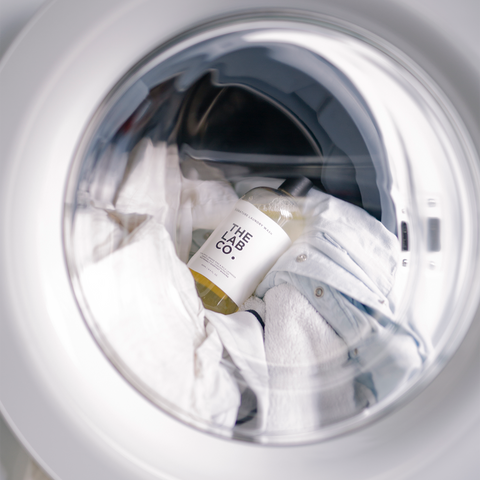
How to Wash Black Clothes
The main challenge with washing black clothes is preventing them from fading. With a few care tips and a set of good instructions, washing dark clothes is quite easy. Read on to learn how to wash black clothes to keep them from fading, and a few extra tips to keep your darker items in perfect condition.
KEEP BLACK CLOTHES FROM FADING IN 8 SIMPLE STEPS
Over time, our favourite edgy pieces tend to fade, but there are ways to delay and prevent this from happening. We have gathered eight tips to help you wash black clothes effectively and keep them from fading. By following these steps, you'll learn how to keep your dark clothes looking sharp and new.
STEP 1: READ ALL GARMENTS CARE LABELS
This is the most important first step to take before washing any item. By not reading it, you could be missing important requirements for laundering your black clothes and cause them to prematurely fade.
Also, not all clothing types are machine washable, especially those made from delicate fabrics such as lace or linen.
STEP 2: SORT YOUR CLOTHES
There are different ways to sort your laundry like a pro. Each person will have their individual routine but we can all agree that sorting your laundry is super important. This can protect your clothing from damage, dye transfers and make for better, more efficient washing. Here are three different ways to sort your clothing:
Separate by fabric type
Not all dark fabrics should be washed together and should be separated accordingly. Heavier fabrics such as towels and jeans should be laundered separately from lightweight fabrics such as cotton or silk. Delicates such as lace, linen and silk should be washed separately.
Separate by colour
Sort your laundry by colour. This helps prevent dye transfer during the washing cycle which can often ruin or damage white or lighter-coloured clothing. Create piles of white, light, and dark clothing. The white pile should include items such as socks, underwear, t-shirts, and other sturdy white cotton items. The light-coloured pile should contain colours such as pink, lavender, light blue, light green, and yellow. Finally, the dark pile should include grey, black, navy, red, and purple items. It's worth considering separating denim into its own pile. You can wash this as a separate load with a specialist denim detergent.
Separate by sub-categories
Get the most out of your time spent washing by organising them into sub-categories and running separate cycles for each. This can help prevent damage to your clothes and other items. For instance, towels and bedding are typically heavier than clothes, and newborn or baby clothes are often light in colour. Creating sub-categories based on these factors can create a much easier way to keep your clothing last longer.

STEP 3: TURN YOUR ITEMS INSIDE OUT & USE A MESH BAG
Laundry cycles can agitate the dye in black and coloured fabrics, which can result in a faded appearance. Although dark clothing can fade over time, this will help prevent it from happening too fast. Place your dark garments in a laundry bag for delicates to protect your items from damage. A mesh laundry bag is great to use with items that have hooks or fastenings that can catch, snag and damage other fabrics in the same wash. The laundry bag also acts as a sneaker wash bag. Place your machine washable trainers in the wash bag and tighten the middle drawstring to keep the sneakers secure.
Tip: Using a net bag avoids trainer laces knotting up.
STEP 4: USE COLD WATER
Set the washing machine to the coldest possible temperature, on a short cycle, and choose a light soil setting for a lightly soiled load.
Dark-coloured clothing is susceptible to losing its colour during a laundry cycle. Washing dark clothes in cold water helps the fibres in dark fabric stay intact. Moreover, washing on a short cycle helps black clothes maintain their colour – the less time they spend in the water the better.
STEP 5: USE THE RIGHT LAUNDRY DETERGENT
Most of the traditional laundry detergents are known to be formulated with harsh chemicals that expedite the damage of the fibres. Using a non-bio, natural laundry detergent can prevent this. Plant-based detergent formulations are just as powerful at cleaning, gentle on the fibres and don’t carry the environmental side effects of their toxic counterparts.
STEP 6: MEASURE YOUR DETERGENT CAREFULLY
Most people have been taught that more detergent means cleaner clothes. However, using too much detergent can actually be detrimental to your garments. This is because too much detergent can create a surplus of suds that can prevent your garments from rubbing together. The rubbing of clothing during a wash cycle helps release trapped dirt. In short, the more detergent you use, the dirtier your clothes may actually end up.
So follow the measuring advice. Most good detergents on the market will be of high concentrate, and little will go a long way.
STEP 7: SELECT A DELICATE OR SHORT CYCLE
The less time that dark and black coloured clothes are in water and the shorter the wash time is, the less likely your clothes are to fade.
STEP 8: HANG TO AIR DRY
Once the cycle is complete, remove the items and hang them to air dry. To prevent fading, avoid exposing dark clothes to the sun. If you choose to tumble dry your dark clothing, it is best practice to do this on low heat with clothes turned inside out. This will reduce the risk of the colour fading from tumble drying.
Some items, such as sweaters or woollen items, should be laid flat to dry instead of hung to help maintain their shape.
Finally, don’t wash your darks so often. This step goes for all clothes and doesn’t apply to just darks. If the garment doesn’t need washing, then get a few more wears out of it by using a fabric mist. Still new to the laundry care routine, fabric mists are hugely undervalued. They are an easy and quick solution to freshening up your textiles. Formulated to soften, clean and boost fragrance, sprays for fabric and textiles are the best way to prolong the life of your items.








